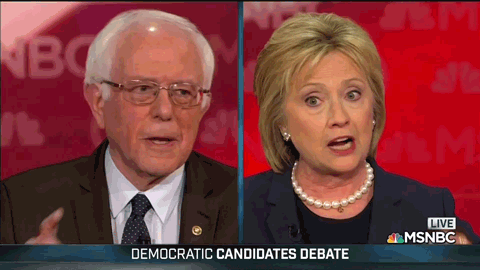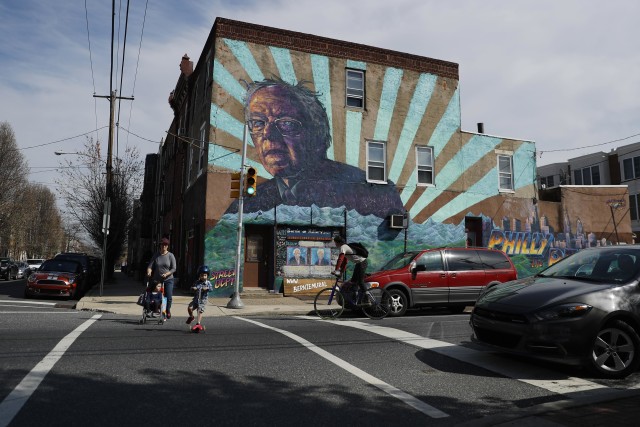
In this increasingly heated primary contest, two of the issues that impact our readers most haven’t exactly been hot-button topics. Candidates rarely discuss funding for the arts or affordable housing in the nation’s rapidly-gentrifying cities.
New Yorkers head to the polls Tuesday, April 19th, and the art school meccas of Providence, Baltimore, Philadelphia, and New Haven will be casting their ballots one week later, on April 27th. The Democratic race for New York has been especially tense, with the April 14th debate at Brooklyn Navy Yard looming on the horizon. How in touch are the candidates with issues pertinent to our readers? For starters, neither one knows how to ride the subway. But both have been staunch advocates for the arts and make claims that they’ll tackle the nation’s affordable housing crisis. I’ve done some digging on how their records on those issues stack up. (See the trainwreck that is the Republican version here) If there’s something you’d like to add to the discussion, feel free to contribute in the comments, but please keep it civil.
Bernie Sanders

A mural of Bernie Sanders in Philadelphia, by Old Broads and Disto
On the Arts:
“I have continued my longstanding commitment to the arts and arts education during my time in Congress, in spite of terrible attacks on the arts from conservative ideologues.You have my promise that as President, I will be an Arts President. I will continue to advocate strongly for robust funding of the arts in our cities, schools, and public spaces. Art is speech. Art is what life is about.”
Bernie Sanders received an A+ score on all of the Americans for the Arts Action Fund Congressional Arts Report Cards for his votes in support of the arts in Congress between 2004 and 2014. To the best of my knowledge, he’s the only candidate with that endorsement, although he is not a member of the Senate Cultural Caucus. They also note that he’s been a vocal proponent of arts education, art therapy for veterans, and spending on culture and education as a means to combat unemployment. As mayor of Burlington, he blocked the development of luxury condos to preserve the open waterfront as public space for cultural programming. Weirdly, the report notes that Sanders recorded an album of spoken-word and protest songs in 1987, in addition to stints as a filmmaker. Sanders has been endorsed by the group Artists and Cultural Leaders for Bernie Sanders.
On Housing:
Sanders has pledged to make affordable housing within reach of working Americans and, as mayor of Burlington in 1984, helped create an innovative affordable housing program. Through the Burlington Community Land Trust, low-income citizens were able to purchase their own homes well below market value. Decades later, the trust is considered a success at combating gentrification while helping economically depressed neighborhoods develop justly. Basically, a trust controlled by community associations retains ownership of land, while low-income households own their individual units, with the goal of keeping the housing stock permanently affordable. It’s such a good idea it’s insane more cities don’t follow this example.
In 2001, Sanders proposed a national Housing Trust Fund, but it was not passed until 2008. In 2011, a deal was struck to fund the trust with profits from Fannie Mae and Freddie Mac. These funds are distributed to states with provisions Sanders included in the bill: that no state receive less than $3 million annually and that up to 10% be spent on affordable homeownership programs. The majority of the funding is set aside to maintain or create new rental units for very low-income households.
Hillary Clinton

Unveiling the Official Portrait of First Lady Hillary Rodham Clinton by Simmie Knox, 2003 (Photo by Mark Wilson/Getty Images)
On the Arts
[All records and quotes from this Americans For the Arts document, unless otherwise linked]
“I support arts education; I support the National Endowment for the Arts. I was one of the leaders during the Clinton administration in trying to keep it alive when Newt Gingrich and others wanted to kill it because I really think that arts education is important on the merits. I was exposed to arts education in a public school system when I was coming up, and I’m no great artist, I think that’s probably well known to people, but it really gave me information and access to thinking about things differently than I would have, so I’m a strong supporter of the arts.”
Hillary Clinton has had a long, complicated career in the public eye. This election cycle, arts and culture haven’t been a major talking point. However, she’s historically been an ardent, outspoken advocate for the arts and arts education, from inaugurating the White House Sculpture Garden as First Lady to joining the Cultural Caucus as a Senator. In the early 2000s, she supported tax deductions for artists’ gifts, but last year announced a plan to cap itemized charitable deductions. That latter tax plan could seriously impact arts nonprofits that rely on donations for funding.
“The arts and humanities depend on partnerships between government agencies, private foundations, corporations, non-profit organizations and individual benefactors to nurture talent and bring the creative achievements of our best artists and artisans to as wide an audience as possible”
Mrs. Clinton’s extracurricular activities and comments pertaining to the art world are just as interesting. In 2013, she wrote an op-ed about the importance of the Art in Embassies program for Vanity Fair. Hillary’s husband, former President Clinton (who she met at a Henry Moore exhibition at Yale), heads the Clinton Foundation, a nonprofit that has some ties to the arts but is better known for other charitable activities. Opinion is divided over whether the Clinton Foundation’s activities and agenda represent a conflict of interest for Mrs. Clinton’s candidacy or if another Clinton in the White House would usher in a golden age of philanthropic cooperation between an increasingly stingy public sector and wealthy private institutions.
The Clintons are known as supporters of the arts in Arkansas, where Bill was governor before becoming President, but that relationship isn’t without conflicts as well. For example, Bill Clinton spoke about the importance of art at the commencement ceremony of the controversial Crystal Bridges Museum, built by the Walton family of Walmart infamy. Hillary Clinton was a major shareholder and served on Walmart’s board of directors for six years while her husband was the governor.
More recently, Hillary alienated many supporters in the art world with her remarks praising Nancy Reagan’s AIDS activism. In reality the Reagans went out of their way to ignore the epidemic, which killed nearly an entire generation of the nation’s artists but inspired countless others to activism and politicized practices.
On Housing

Under the Hope VI program, many cities lost a substantial chunk of their public housing stock, such as these highrises in Downtown Baltimore, which were cleared to make way for suburban-style developments.
Clinton’s record on housing and urban issues is spotty. She’s spoken out about the need for more affordable housing, but as First Lady, supported many programs that were pretty bad for low-income people in cities. During the Clinton presidency, funding for affordable housing was slashed by $16 billion (60%) while funding for prisons was more than tripled by $19 billion to accommodate the escalation of the War on Drugs. The Hope VI program, which the Clintons supported, opted to demolish high-density public housing (rather than maintain it and restore funding to social programs) and replaced it with lower-density suburban-style private developments that included a lower percentage of affordable housing. Said program has been widely criticized for gutting the nation’s cities of affordable housing, and in conjunction with the Clintons’ “tough on crime” policies, displaced millions of low income people. These are the policies that escalated gentrification throughout the 90s, paving the way for the crisis we have today.
In this election cycle, she’s proposed $25 billion in spending on housing, mostly through tax credits for developers (the National Association of Homebuilders endorses the plan). Its stated goal is primarily to lower the cost of homeownership, but also create new affordable rental units. Troublingly, addressing “blight” is one of the program goals, so it might incentivize gentrification in poor areas.


{ 1 trackback }